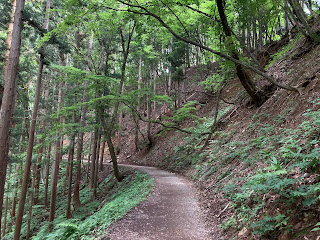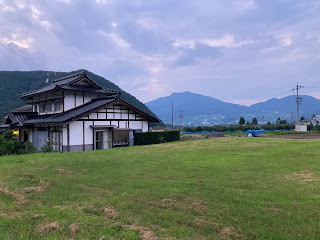Japan 2023: Nagano
by Justin Dunn | July 30, 2023
I’m sure you have all heard of Tokyo, the most populous city in the world (by some measurements), but my guess is not many of you have ever heard of Nagano, the 54th largest city in Japan. Nagano, and its 370,000 inhabitants, sit in the mountains about a two hour train ride north of Tokyo. It’s a popular ski town and hosted the 1998 Winter Olympics. Most importantly, this is where Ryan and I continued our trip after leaving Tokyo.
Last Saturday, July 22, Ryan and I packed our bags and headed to Tokyo Station. There, we boarded our Shinkansen. Japan has a system of bullet trains that run all across the country and allow for easy access to pretty much anywhere you’d want to go to. The trip to Nagano was beautiful. We flew past the countryside, past rice fields and mountains. Unfortunately, our seats were on the eastern side of the train so we were not able to see Mount Fuji, the iconic volcano depicted over and over again in Japanese art.
On arriving to Nagano Station, we realized that we were in dire need of an Automated Teller Machine, as the guest house we were spending the night in was cash-only and we had used most of our cash in Tokyo. Fortunately, the train station had an ATM. Unfortunately, the ATM didn’t accept foreign cards. Fortunately, the department store across the street also had an ATM. Unfortunately, that one didn’t work either. Finally, after doing some research on trusty Google, we found out that 7-Elevens, an American convenience store which for some reason is all over Japan, all have ATMs that support American cards, and we were able to withdraw enough cash to pay for our stay.
After this somewhat stressful interlude, we went back to the station and took the Snow Monkey Express to Yudanaka station. Why is it called the Snow Monkey Express? You’ll find out in a sec. Yudanaka is a popular onsen (hot spring) town, with great access to the ski resorts in the mountains surrounding Nagano. It also happens to be an eight-minute drive from the Jigokudani Monkey Park. You’ve probably seen pictures of these monkeys, even if you didn’t know this is where they were from. Jigokudani is home to its very own hot spring, which Japanese macaques play in year round. These macaques are often called “snow monkeys” because they are the only non-human primate to spend a couple months of the year in areas covered in snow. The monkeys we saw at Jigokudani like to spend their winters relaxing in the natural warmth of the hot spring. The monkey park was really fun to go to, not only because we got to see a bunch of really cute monkeys (and a bunch of other tourists), but also because the park itself is located about two kilometers into the forest. It was incredibly well preserved, consisting mostly of cedars, oaks, and maples, and was absolutely breathtaking.
 |
| Japanese Macaques |
 |
| Mother macaques grow longer hair for their babies to hold on to. |
 |
| Path to the monkey park |
After the monkey park, Ryan and I enjoyed some soft ice cream while waiting for our host at the guest house to come pick us up. Instead of offering a regular twist with chocolate and vanilla, a lot of places here have different flavors. This place’s flavors were apple and milk. It was actually pretty good!
Anyway, our stay in Yudanaka was pretty chill. Our room in the the guest house was nice. It had traditional tatami mats and two mats laid on the ground. It was small but got the job done. The reason we went to Yudanaka was because there’s a Hokusai museum in the town right next door. Our host drove Ryan, me, and a French guest to the museum the next morning. The exhibit was on all of Hokusai’s depictions of aquatic life, which apparently there are a lot. Over his 90-year life, this guy made a ton of drawing guides for other artists and basically drew everything you can imagine.
 |
| Under the Wave Off Kanagawa from Obuse Hokusai Museum |
 |
| Hokusai’s Quick Lessons in Simple Drawings |
It was really cool to meet the French guest who went to the museum with us. She was in Japan learning Japanese, her 6th language after French, English, Italian, Spanish, and Persian. Her job has something to do with cross-culture literary analysis. It was very nice to be able to have a real conversation with someone other than my brother. She had to catch a Shinkansen to Tokyo so we said bye after the museum. Next, Ryan and I got lunch. The region is famous for chestnuts and soba wheat noodles, so that’s what we ordered. It was delectable.
Then, to finish our stay, we headed to a hot spring. It had a cute little restaurant area where we ate dinner, and then we went into the men’s locker room area. Onsens have a lot of rules, so if you ever go to one, make sure you do your research. We thought we had done enough, but alas, we still felt a little lost. You’re supposed to keep the onsen as clean as possible, so we washed with soap and shampoo before going in. It was hot. Very hot. It was a pretty weird experience, but I think it was a good one. I’d do it again.

View from the road on our way to the onsen
The next morning, we headed to Hiroshima. I’ll tell you about that in the next blog. Until then, keep being you and enjoy your summer! See you next time!
- Justin Dunn
